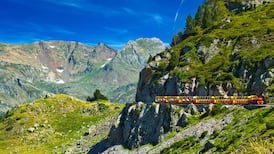Italy was my first love. It entered my life 60 years ago through the lovely plaintive lament of Gigliola Cinquetti, and the moody musicality of her words: “Non ho l’eta per amarti” (I’m not old enough to love you) on our small black-and-white family television of the time. Apparently I wasn’t alone. Somewhere, a 13-year-old Dana was watching, also enthralled and inspired, and six years later in 1970 she joined Gigliola as a Eurovision winner.
Inspired by Gigliola, I set off to learn Italian and get to know Italy. Over the decades, starting in 1966, I hitchhiked, backpacked, skied and climbed in its high Alpine mountains, and in 2012, I cycled from Naples to Brindisi on my way to Istanbul. Gradually, I swapped my teenage love for Gigliola for a more enduring affection for her language and for la Bel Paese, her beautiful country.
And so, I am glad to be back, immersed in Italy at its best, on a lovely spring morning in a region and place I have never visited – never even been aware of – in those long decades since my first trip to the country in 1966. My wife and I are in Monterosso, the most northerly and largest of the five beautiful villages of Cinque Terre on the Ligurian coast of Italy, settling in with that first real, relaxed holiday coffee.
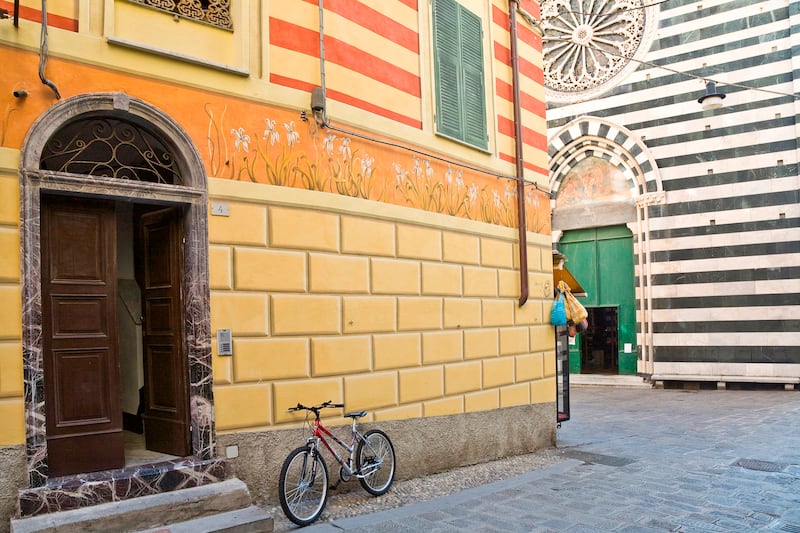
Our travel day is behind us. We have flown Ryanair from Dublin to Pisa, and onwards by airport shuttle and train to Monterosso al Mare, the “new” part of Monterosso. We have dragged our cases the short distance from the railway station to our accommodation along a spectacular seafront walkway, and through a short pedestrian tunnel punched through the headland that separates our destination, the old town, from the “new”.
READ MORE
The next morning, we emerge from the “Captain’s House”, a lovely little rented boutique apartment in the old town, and pick our way carefully down a curving stepped stone alleyway, surrounded by little shops and stalls and open church doors and well-stocked minimarkets. In no time, we step out of the dark shadow of the 13th-century Church of San Giovanni Battista, with its facade of white Carrara marble and black serpentine, and into the warm sunshine of wisteria-fringed, and invitingly table-strewn, Piazza Garibaldi.
The church bells ring out nine times, and exuberant, chatty groups of boot-clad hikers of all ages and sizes stroll by us, poles scraping or tapping on flagstone as they go. We watch as hike leaders pause, seeking out the tell-tale red-and-white markers that guide walkers through the villages and over the hills of this Unesco World Heritage Site with its 125km of well-marked and graded trails.
An elevated train roars out of a tunnel close by, and just as suddenly back into another, disturbing no one. By the second cup of coffee, we are already delighted we have committed to five days in Cinque Terre and have passed up on the other powerful attractions in the vicinity of Pisa, such as Lucca, Siena and Florence. The five villages, and their hills and shores, would be our home for five days.
Later we set off with poles and light boots to walk the short 5km to Vernazza, the oldest of the five villages and the next one along the coast to the south of Monterosso. The busy trail is impossible to miss, as it curves up out of the beach area on to the jutting headland separating the two villages.
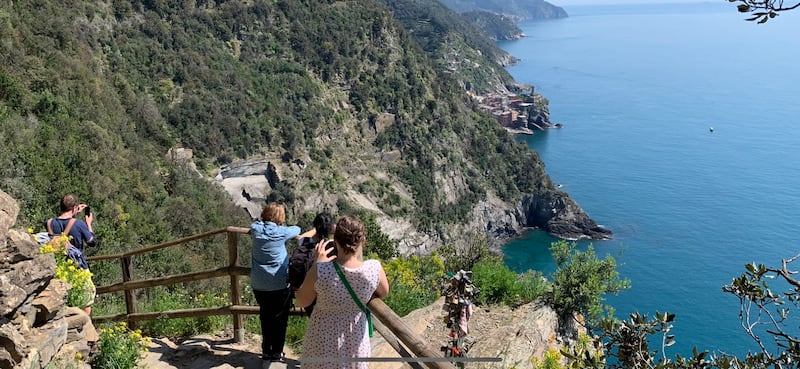
This walk is not to be underestimated. There are frequent steep steps, some rough, uneven ground, often very narrow pathways and lots of oncoming and following fellow hikers, requiring care and attention. But this is a most beautiful hike along flower-fringed trails, bounded by old drystone terrace walls, with views of an azure sea below us to our right as we go. We stop to listen to birdsong and peruse the natural and social history information panels along the way. Before long we begin our descent, and the lovely pastel curving village and spectacular harbour piazza of Vernazza appear below us. We stop just to be mindful and appreciative of the special Italian place we have come to.
This is a stretch of coast, maybe 20km in length, bookended by two great jutting headlands to the north and south, backed by an almost impenetrable mountain range reaching up to nearly 800m and fronted by an often-turbulent Ligurian Sea. Its wooded hillsides and streams knew only nature and passing boats until first settled about 1,000 years ago. Over the centuries, generations of hardy souls made it home, creating a new landscape of terraced olive and grape and lemon mini-orchards, and ultimately thriving fishing and farming-based trading economy.
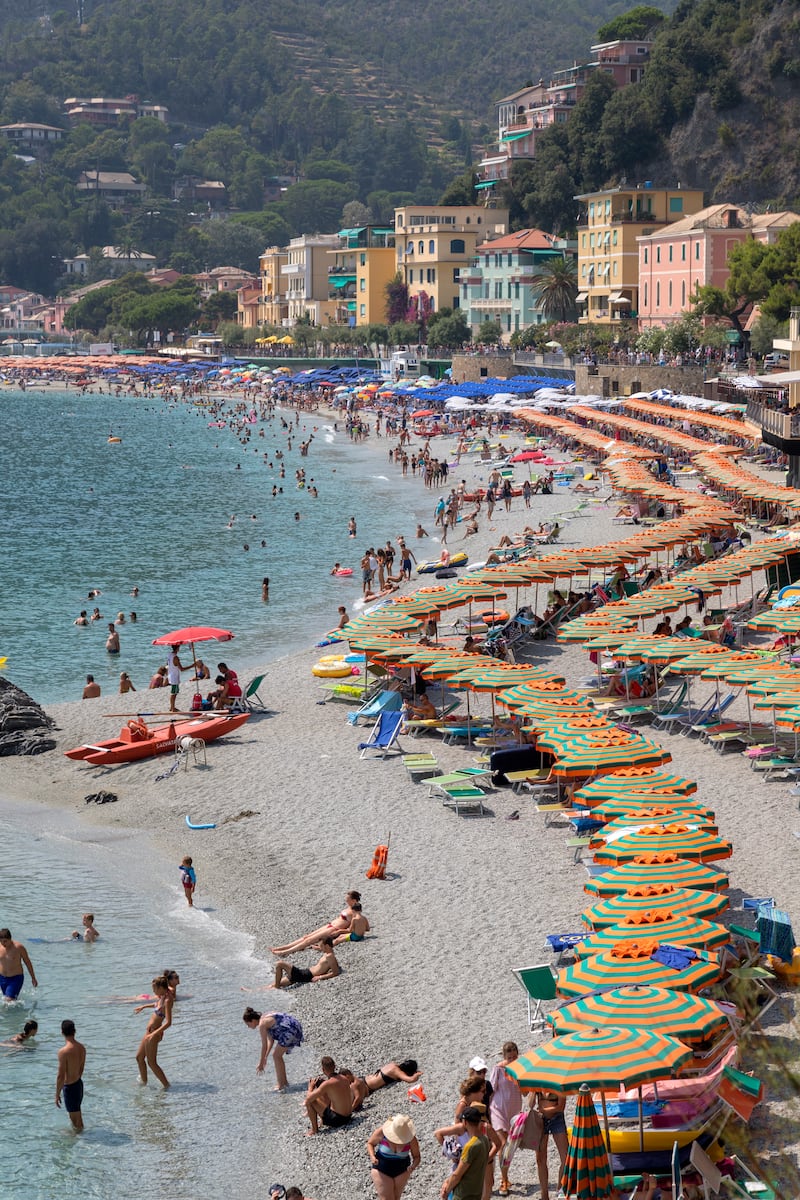
The villages, strung along a late-19th-century coastal railway line, only became accessible by road about 50 years ago and even now are all pedestrianised. We rarely see a motor vehicle during our five days. As a result, wandering through the wide piazzas and village streets is a real pleasure and relief for the happy, milling throngs of visitors, including us. And the steep old inter-village pathways, left to us by previous farming and fishing families, are now the choices of a multitude of happy hikers.
We return to Monterosso al Mare by train in three minutes – versus the outward hike of nearly three hours. Much later we watch the sunset from one of the lovely, perched stone balconies of the Aurora Restaurant, an old Genoese watchtower on that jutting headland between the old and new towns. Later still we are treated to rousing and romantic music by a beachfront mini-orchestra in Monterosso al Mare, warming ourselves against a wall that gives us back the heat of a long, sunny day.
On the following days, we revel in the possibilities offered by the inter-village rail service. On two occasions, we breakfast over excellent bacon and egg in our local Piazza Garibaldi, hop on to the train and enjoy morning coffee in another village along the coast, in a different ambience. On two other occasions, we set out by train down the coast for our evening meals to Riomaggiore and Cornelia.
In Riomaggiore, we eat in a restaurant perched above the harbour and little marina and join with happy throngs of people in celebrating a beautiful slow, fiery sunset. All about us people watch from restaurants and bars and the shore, and some from small boats, just hanging out on a limpid sea. Undoubtedly, our most enjoyable sunset-seeking expedition is to Cornelia. Even after a day’s hiking and hanging out in and above Manarola, the 380 steps from the station up to this beautiful hilltop village do not faze us. Our efforts are rewarded by finding the most enchanting little restaurant, Marina di Cornelia, and a perfect sunset.
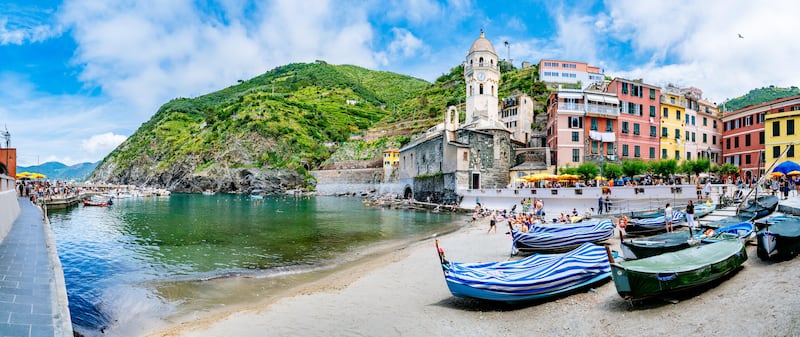
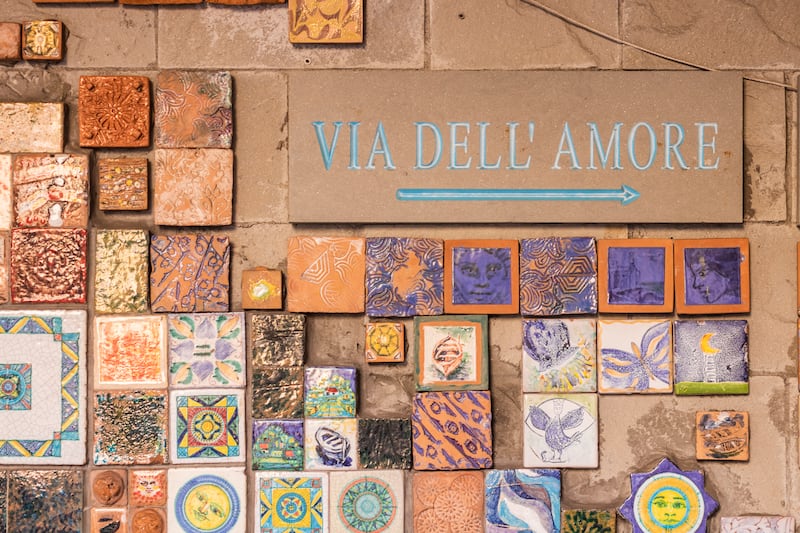

Over our stay in Cinque Terre, we eat ice-cream and seafood and pastas and bruschettas and morning croissants. We drink Aperols and local wines and many varieties of coffees. But mostly, we walk and walk, or just hang out, through the unbroken warm sunshine. At times we feel that the ever-present steps up and down that hilly topography, though character-giving and -making, are a bit trying.
My wife opts out one day while I hike the often olive-shaded path between Cornelia and Vernazza. I take my time and a good hour on the lovely high wayside terrace of the Bar il Gabbiano. A special mindful moment for me is hearing the pealing of distant midday bells, seemingly from the 13th-century Church of San Pietro away down below in Cornelia, by now my favourite village.
On our last day, we take the ferry from Monterosso and stop off for lunches, coffees, cokes and cakes in Vernazza and Riomaggiore. From the sea the paths we have travelled out of all the villages over the previous days seems both daunting and inviting. And on the day we leave by train for Pisa, the sea shows us its wild side. But a bright sun and warm wind and a sea of blue and white sparkle lends a new beauty, though with hints of disruptive power and possibly lengthy isolations.
Our days in Cinque Terre are among the most enjoyable we’ve ever shared. The sheer beauty of the place, its exclusive island feel, the easy accessibility of train and sea transport, the almost total absence of cars and busses and taxis and buzzing Vespas, the friendliness of the Italian people there, the choice of food and salons, bars, shops and restaurants, its style and people-watching opportunities, and especially the walking options, all make for a unique holiday experience.
Yes, the villages are busy and the train platforms and loo queues, especially in Vernazza, are bedlam at times. But there is a strange primal attraction in being part of milling, happy crowds, on seafronts and little harbours and on terraces and little narrow alleyways in the villages, especially on the occasion in Riomaggiore when we watch the sunset together.
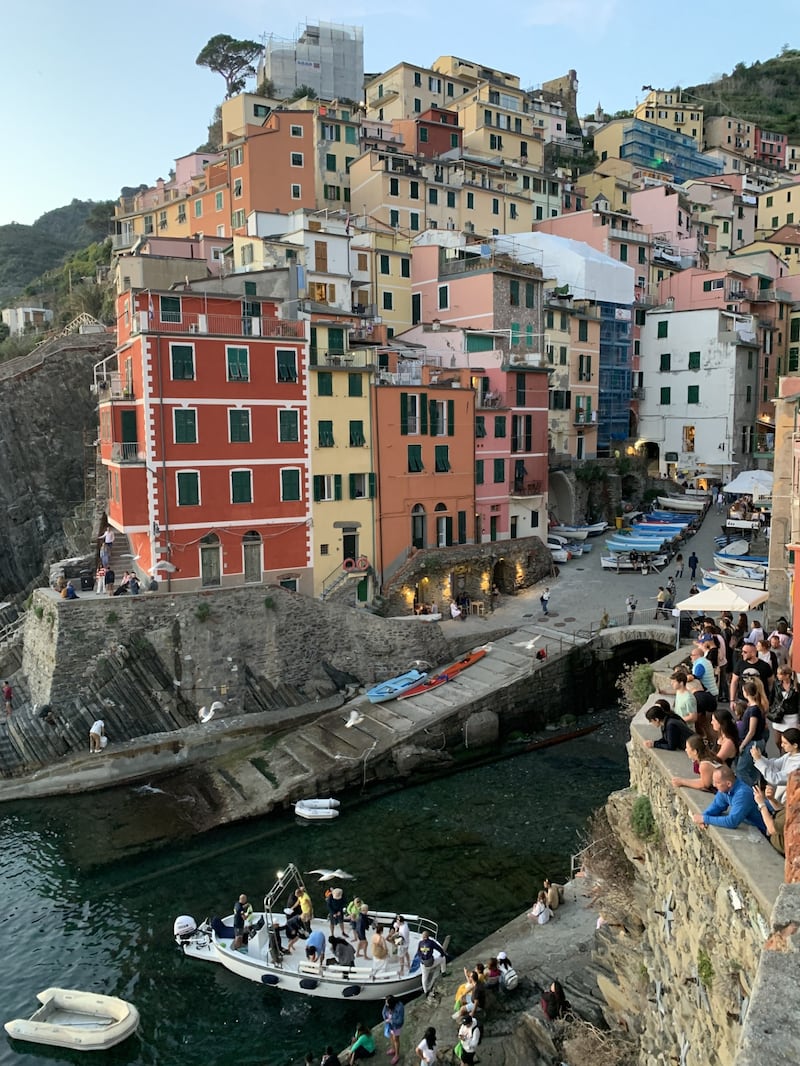
There is a plethora of mostly marine activities that we do not avail of, and we do not climb up to every high Genoese lookout tower, nor see the beautiful interiors of every church and monastery, with their renowned works of local and visiting artists and sculptors. Nor do we fully explore the hills behind the villages with their networks of trails and high hillside hamlets. But we have done enough to fall in love with Cinque Terre, in our own way and at our own pace.
Okay, I don’t find Gigliola Cinquetti but I leave Cinque Terre with a renewed love for her language, and for the warm people and landscapes of her country, La Bella Italia.





